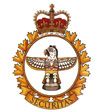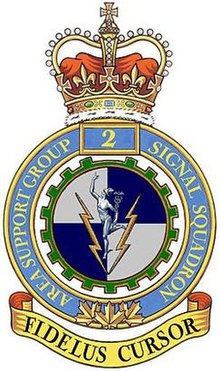
The Canadian Army is the command responsible for the operational readiness of the conventional ground forces of the Canadian Armed Forces. It maintains regular forces units at bases across Canada, and is also responsible for the Army Reserve, the largest component of the Primary Reserve. The Army is headed by the Commander of the Canadian Army and Chief of the Army Staff, who is subordinate to the Chief of the Defence Staff. The Army is also supported by 3,000 civilian employees from the public service.

Yeomanry is a designation used by a number of units and sub-units in the British Army Reserve which are descended from volunteer cavalry regiments that now serve in a variety of different roles.

The Royal Corps of Signals is one of the combat support arms of the British Army. Signals units are among the first into action, providing the battlefield communications and information systems essential to all operations. Royal Signals units provide the full telecommunications infrastructure for the Army wherever they operate in the world. The Corps has its own engineers, logistics experts and systems operators to run radio and area networks in the field. It is responsible for installing, maintaining and operating all types of telecommunications equipment and information systems, providing command support to commanders and their headquarters, and conducting electronic warfare against enemy communications.

The 4th Canadian Division is a formation of the Canadian Army. The division was first created as a formation of the Canadian Corps during the First World War. During the Second World War the division was reactivated as the 4th Canadian Infantry Division in 1941 and then converted to armour and redesignated as the 4th Canadian (Armoured) Division. Beginning in 1916 the division adopted a distinctive green-coloured formation patch as its insignia. In 2013 it was announced that Land Force Central Area would be redesignated 4th Canadian Division. It is currently responsible for Canadian Army operations in the Canadian province of Ontario and is headquartered at Denison Armoury in Toronto.

The Royal Canadian Dragoons (RCD) is the senior armoured regiment of the Canadian Army by precedence. It is one of three armoured regiments in the Regular Force and forms part of the Royal Canadian Armoured Corps.

The Canadian Forces Military Police provide police, security and operational support services to the Canadian Armed Forces (CAF) and the Department of National Defence (DND) worldwide.

2 Canadian Mechanized Brigade Group Headquarters & Signal Squadron is a Regular Force Army unit of the Canadian Forces garrisoned at Canadian Forces Base (CFB) Petawawa. The unit's parent formation is 2 Canadian Mechanized Brigade Group. The squadron was housed in eight separate buildings but consolidated into one in 2011.
This is the structure of the Canadian Army, as of August 2022.

The Communications and Electronics Branch is a personnel branch of the Canadian Armed Forces (CAF). The army component of the branch is designated the Royal Canadian Corps of Signals.

The Corps of Royal Canadian Electrical and Mechanical Engineers (RCEME) is a personnel branch of the Canadian Armed Forces (CF) that provides army engineering maintenance support. All members of the corps wear army uniform. From the 1980s to 2013 it was called the Electrical and Mechanical Engineering Branch.

The Lynx reconnaissance vehicle is a United States-built tracked reconnaissance armoured fighting vehicle, which was employed by the armed forces of the Netherlands and Canada. Dutch vehicles were exported in the 1990s to Bahrain and Chile, according to SIPRI 150 and 8 vehicles respectively.
A service battalion is a unit of the Canadian Armed Forces (CAF) that provides combat service support to a brigade group and its elements.

36 (Eastern) Signal Regiment was a Territorial Army (TA) signal unit of the British Army's Royal Corps of Signals (RCS). The regiment was formed following the formation of the TAVR in 1967, and was disbanded in 2009 following a reorganisation in the RCS. Though not disbanded, the regiment continues its lineage as a squadron, with its own former squadrons forming troops within said squadron.

The Rhodesian Security Forces were the military forces of the Rhodesian government. The Rhodesian Security Forces consisted of a ground force, the Rhodesian Air Force, the British South Africa Police, and various personnel affiliated to the Rhodesian Ministry of Internal Affairs. Despite the impact of economic and diplomatic sanctions, Rhodesia was able to develop and maintain a potent and professional military capability.

2 Military Police Regiment is a unit of the Canadian Forces. It provides support to the Canadian Army within the Province of Ontario. It does not provide support to Canadian Forces Bases Borden, Trenton and North Bay and Canadian Forces Support Unit (Ottawa). The unit was initially created in the summer of 2006. Since then, the unit was officially established by a ministerial organization order (MOO) and a Canadian Forces organization order (CFOO) dated September 24, 2007. It is a "total force" unit of the Canadian Army Military Police Group (CA MP Gp). The term total force describes a unit which includes both Regular Force and Reserve Force members. 2 MP Regt is responsible for police, security and detention operations as well as police support in field operations. The unit headquarters is located at the George Taylor Denison III Armoury, more commonly known as Denison Armoury, in Toronto, Ontario. The strength of 2 MP Regt totals just under 300 personnel. Since the transfer of command authority (TOCA) on 1 April 2011, 2 MP Regt is under the full command of the Canadian Forces Military Police Group through the CA MP Gp, and attached operational command (OPCOM) to the 4th Canadian Division. The unit is commanded by a major as the commanding officer (CO) and the unit has a master warrant officer who is the regimental sergeant major (RSM). The CO of 2 MP Regt reports directly to the commander of the CA MP Gp, as well as the commander of 4 Cdn Div. The CO has a dual function as commanding officer and division provost marshal.
The 2nd Combat Engineer Regiment (2 CER) is an Australian Army combat engineer regiment located at Gallipoli Barracks in Brisbane, Queensland. It is part of the Australian 7th Brigade, attached to Forces Command (Australia).

21 Electronic Warfare Regiment is a Communications and Electronics Branch regiment in the Canadian Army, based in Kingston, Ontario. 21 EW Regt exists to provide trained army electronic warfare operators and support personnel to the Canadian Armed Forces. 214 Electronic Warfare Squadron is the only Reserve electronic warfare squadron within the Canadian Armed Forces that is a part of a Regular Force regiment. Many of its members serve in various UN and NATO peacekeeping missions around the world.

41 Signal Regiment is a reserve communications unit of the Royal Canadian Corps of Signals. It is part of 41 Canadian Brigade Group in Alberta. The unit consists of:

33 Service Battalion is a Canadian Forces Primary Reserve unit with three companies located in northern and eastern Ontario - at the M.L. Troy Armoury in North Bay, Pine Street Armoury in Sault Ste Marie, and the Major Holland Armoury in Ottawa. The battalion is under command of 33 Canadian Brigade Group, itself commanded by the 4th Canadian Division. The battalion is made up of officers and soldiers primarily from the Royal Canadian Logistics Service and the Royal Canadian Electrical and Mechanical Engineers providing Combat Service Support to 33 Canadian Brigade Group and other military organizations in eastern and northern Ontario - by means of transportation, supply, administration, food services, and mechanical repair and recovery activities.
The following is a hierarchical outline for the Canadian Armed Forces at the end of the Cold War. It is intended to convey the connections and relationships between units and formations.















